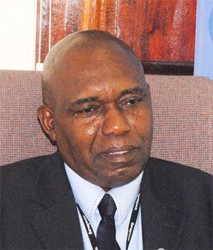“Guyana has all of the ingredients necessary to reclaim its position as the bread basket of the Caribbean and the region needs to focus on cultivating high-yielding varieties of [cassava] as well as addressing the processing and commercialization considerations associated with [its] popularization,” newly appointed Food and Agriculture Organization (FAO) Resident Representative in Guyana, Reuben Robertson has told Stabroek Business.
He said addressing regional consumption patterns would increase the demand for cassava through a region-wide education process,

Reuben Robertson
“A significant portion of that US$4 billion annual food import bill is spent on the importation of maize, cereal and wheat. Cassava can provide about 30 to 40 per cent of our feed mix in the region and can probably account for 30% of the mix in the production of flour,” Robertson said. He added that the enhanced infusion of cassava into regional food consumption “can ensure that a significant proportion of that US$4 billion remains in the region.”
On Sunday, the FAO announced from its office in Belize that it had launched a regional project to support the development of the cassava industry in the region. The release on the initiative named seven countries – Barbados, Belize, Grenada, Guyana, Jamaica, St Lucia and St Vincent – which it said would benefit directly from the US$500,000 project but that the other territories in the region will also benefit from the outputs of the project which, it says, “aims to replace up to 30 per cent of the wheat flour with cassava in baked products, feed products and other industrial and household uses.”
Cassava has been identified by regional governments as “one of the priority crops with great potential to contribute to addressing agricultural revitalization and the (high) food import bill. During this week’s interview the local FAO Resident Representative endorsed the view expressed by FAO Regional Coordinator for the Caribbean Dr Deep Ford at a workshop held last week to launch the project that cassava could become “a new pillar of economic development and agricultural revitalization.”
Robertson alluded to the fact that the Jamaican brewing company Red Stripe had recently announced its intention to undertake a multi-million dollar investment over the next five years in the creation of a cassava supply chain in order to offset the high costs of barley imports used in the beer industry. This week Robertson told Stabroek Business that the continually growing importance as a “feed and food staple” meant the region now needed to focus on the cultivation of high-yielding varieties of cassava as well as on the processing and commercialization of the crop and on educating the people of the region on the importance of cassava. Robertson said that in contemplating the cassava consumption in the region vis-a-vis the consumption of imported foods it was necessary for the region to look at “the price of the commodity” and the health benefits to the region as a whole and for consumers to examine the individual health benefits to be derived from the consumption of fresh foods as against processed/imported foods. There is a need to look at the price of cassava as well as the end result in terms of health benefits to the nation and to individual. The FAO has said that much of the attraction to cassava as a potentially strategic food staple in the region has to do with the fact that “cassava is a climate-smart crop which tolerates drought, and some degree of flooding. It is gluten-free and has other attractive health benefits.
Last week’s Third Meeting of the Regional Cassava Working Group addressed the need for the creation of “a comprehensive strategy” to step up the involvement of national and regional stakeholders and the private sector in the project. Robertson said he regarded the private sector as an integral part of the project. The private sector, he said, not only comprised the entrepreneurs but also “the small farmers who investments in the project are bound to be critical to its success.”




